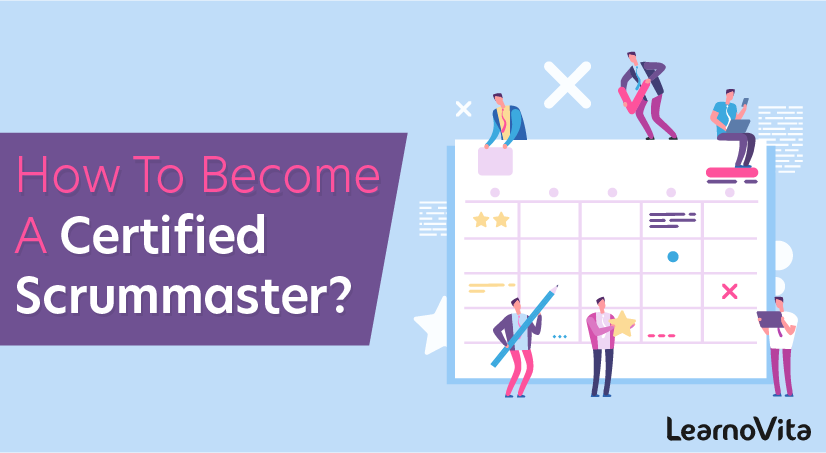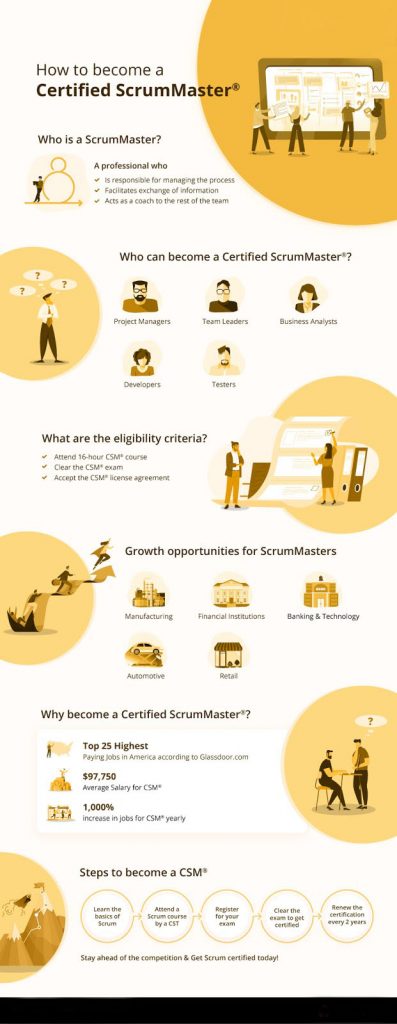
How to Become a Certified ScrumMaster?
Last updated on 14th Oct 2020, Artciles, Blog
What is a Scrum Master?
A Scrum Master holds a position that’s relatively narrow in scope, yet extremely broad in influence throughout any organization. In practice, however, a Scrum Master is working behind the scenes and is not involved in product ideation or strategy. They work more as a conduit between product/line-of-business owners and development teams as a project manager. Because agile processes are entirely dependent on people and collaboration, Scrum Masters must also marry soft skills with the latest tools and methods. After all, software projects have many moving parts, and individual programmers can quickly lose sight of the broader scope when heads-down in code. A Scrum Master, on the other hand, maintains a high-level view, helping teams to understand both organizational and technical dependencies while avoiding chokepoints. This creates a culture of accountability and enables teams to meet critical deadlines.
So now, as you are well aware of what a scrum master is, it’s time for you to understand the roles and responsibilities of a scrum master.
Scrum Master Responsibilities
- 1. Implement Project Management/Best Practices: The Scrum Master is responsible for creating and onboarding project teams, integrating them into the organization and providing a clear vision of the product. The Scrum Master also facilitates communication and information exchange between external groups and the project team. They also monitor project progress, provide timely feedback, and drive a culture of agility and learning.
- 2. Keep all Parties on Track and Informed: The Scrum Master hosts daily team meetings to get updates on the progress of the project, address potential roadblocks, and ensure that the project is on track. They also host regular sessions to share updates with product stakeholders about how the project is progressing (or not). Ultimately, it’s a Scrum Master’s job to ensure that the team is meeting deadlines with the desired outcome.
- 3. Introduce Agile Engineering Practices: To improve efficiency, Scrum Masters encourage the use of continuous integration (CI) and automation. With CI tools, developers integrate chunks of code into a central repository frequently, from which automated builds and tests run in successive iterations. This repeatable approach reduces the risk, time, and effort associated with traditional development methods. For instance, if a bug appears in one build, it can quickly be fixed in the next. Another agile technique Scrum Masters advocate is “pair programming”, where two developers collaborate in real-time and at the same workstation. Altogether, these practices reduce development time and improve the architecture and quality of the product.
Subscribe For Free Demo
Error: Contact form not found.
Scrum Master Roles
Product Owner
The scrum master’s role in supporting product owners in the following aspects:
- Find methods to effectively manage the product backlog.
- Help communicate the owner’s wishlist to the project team.
- Arrange and optimize product backlog.
- Organize scrum events as necessary.
Organization
The scrum master’s role in the organization in the following aspects:
- Lead and coach scrum adoption.
- Plan scrum implementation.
- Implement changes and steps to increase the team’s productivity.
- Collaborate with other scrum masters to improve the methodologies’ efficiency.
So, as we have learned the roles and responsibilities of a scrum master, it’s also important for you to understand the top qualities to become a successful scrum master.
Top Qualities of a Successful Scrum Master
- 1. Influential: A Scrum Master leads various teams that are working on a project to achieve specific milestones and deliverables. They must be able to motivate multiple groups and stakeholders at an organizational level, maximizing the potential of all at stake. As a team leader, the Scrum Master must bridge the gap between the concept of the project and the actions required to complete it. The Scrum Master must have strong leadership and organizational skills.
- 2. Collaborative: The Scrum Master forms an essential link between the product owner and project teams. While the product owner drives the overall initiative, the Scrum Master nurtures the team. Effective collaboration between the Scrum Master and product owner ultimately result in successful products that meet the organization’s requirements. A good Scrum Master should be able to find creative ways to increase organization, collaboration, and productivity to deliver the product the business line owner requested.
- 3. Observant: The Scrum Master is not a manager, but a team member and facilitator. They should be good listeners and pay attention to the challenges the project team is facing at every step of the way. The Scrum Master should also be observant, paying attention to the team’s daily activities to gain a clear view of members’ roles and contributions in sprint sessions.
- 4. Knowledgeable: Besides resolving and issues that arise, the Scrum Master should also proactively prevent potential problems. This requires overarching knowledge about the product and process. The Scrum Master’s experience enables the team to avoid roadblocks. The Scrum Master should possess knowledge of various work formats and agile methodologies such as XP, Lean, and Kanban.
Who is the Scrum Master?
Wearing different hats, coach, enabler, facilitator, team leader, problem-solver, s/he is in charge of giving right directions to team members so that they reach objectives. First promoter of Agile mindset, values and principles, the Scrum Master uses the Scrum framework to help a team in understanding, working on, and achieving a common goal.
Responsibilities of the Certified Scrum Master
It is expected from the Certified Scrum Master to promote an Agile way of working and to lead Scrum implementation in order to improve the team’s overall performance. It implies these activities:
- Teaching Agile values and principles and ensuring they have been understood and adopted by the Scrum Team, and even by the whole organization if possible (and relevant)
- Implementing the Scrum framework so that it fits the needs expressed by the Scrum Team
- Listening, observing and reflecting on how the Scrum Team is reacting to first changes, then selecting and adapting Scrum elements accordingly.
- Protecting Team Members from any interference or troubles that make them losing focus on their primary work
- Anticipating, identifying and removing any impediments, and coaching Team Members to learn to solve these situations by themselves
- Helping the Product Owner to manage the Product Backlog so that time-to-market is reduced and every increment brings value to end customers
- Acting as a Servant Leader

Requirements to become a Certified Scrum Master
Getting some basic knowledge about the Scrum framework is a nice-to-have prerequisite. However, the first mandatory step is to attend a two-day CSM course conducted by a Certified Scrum Trainer® (CST®). This course will prepare you well for the CSM exam by delivering insights about how to organize and support a Scrum Team. The final step is easy: you need to accept the License Agreement and update your Scrum Alliance membership profile.
Why you should be a Certified Scrum Master?
Becoming a Certified Scrum Master is one way to expand your career opportunities. Indeed, Agile is spreading everywhere in organisations, in all industries. Strongly correlated, software and digitalization are eating the world, so the need for Scrum Masters in software development is increasing. It is also the beginning of a long journey: it enables you to engage with other Scrum practitioners all over the world, to share best practices, to solve common issues and to promote Agile values and continuous improvement.
Besides, this certification offers you to learn foundation of Scrum and scope of the role of Scrum Master. And because it is delivered by Scrum Alliance , this is a very valid proof of your Scrum knowledge.
What do I need to do to become a CSM?
A true belief and strong interest in Agile philosophy will help for sure to get knowledge, to practice efficiently and to stand out among Agile practitioners. Nonetheless, passing the Scrum Alliance certification for Scrum Master lies mainly in learning Scrum fundamentals and attending to the two-day training (see above paragraph c.)
a. Why CSM over PSM: Best Scrum Master certification
1. Scrum.org courses- Price, Renewal, Pros, and Cons
- Price: It includes exam fees but depends on content, duration, trainer and location:
- US: $1500
- Europe: 1500 euros
- India: INR 26,000
- Renewal: No expiration (lifetime certification)
- Pros:
- Course content is officially designed by Scrum.org so all teachers deliver same content. It implies that Scrum.org selects qualified instructors and ensures students learn the same core content.
- Exam can be taken without attending course – Exam fees are $150
- There is an online free assessment exam for practising
- Cons:
- Exam is much harder than CSM. It requires experience, and deep theoretical knowledge
2. Difference between the Scrum Alliance and Scrum.org courses
The main difference lies in the fact that Scrum.org provides standard curriculum and course content, while training conducted to become CSM depends on individual trainers experience, opinion and knowledge.
CSM Certification Training
Syllabus of Scrum Master certification

Scrum Alliance provides a list of selected resources to learn the Scrum framework. People who want to become Certified Scrum Master are invited to read articles from experts like Mike Cohn or Steve Denning, or from other members. One specific advantage with Scrum Alliance lies in their elearning series: a dozen short videos introduce Scrum Theory and Values, Scrum Roles, Scrum Events and Scrum Artifacts.
Besides, it is strongly recommended to read those references:
- the Scrum Guide by Ken Schwaber and Jeff Sutherland
- the Scrum Primer by Pete Deemer, Gabrielle Benefield, Craig Larman and Bas Vodde
- the Do Better Scrum by Peter Hundermark
Not mandatory but relevant to go further, Scrum: A Pocket Guide by Gunther Verheyen
and Software in 30 days by Ken Schwaber.
Exam and Certification Information
Scrum Alliance courses- Price, Renewal, Pros and Cons
- The CSM course is a two-day (16 hours) course delivered by a Certified Scrum Trainer® (CST®).
- There is no standard fee, so the price can vary depending on the context: trainer, content, location, date ; the usual range is from 1000 to 1500 euros (or from 1150 to 1750 dollars).
- It includes two attempts to take the CSM exam and a two-year membership to the new Scrum Alliance® community. Those two attempts have to be used in the next 90 days after attendees receive the welcome email to pass the test. Beyond this duration, they will be prompted to pay $25 to take the exam. Certification is valid for two years, then it requires to be renewed after that.
Besides, attendees to the CSM course will be granted with 14 PDUs credits: 10 PDUs in Technical Project Management and 4 PDUs in Leadership.
What can be considered as a drawback is that there is no standard content course. Course materials are made by individual trainers, which implies it can be limited by their experience and opinion.
Cost of the Scrum Master Certification
There is no specific cost for the Certification: fee is included into the CSM two-day course.
The structure of the exam
The exam is composed of 35 multiple-choice and true/false questions. At least 24 correct answers are required to pass the exam, and there is no time limit to answer those questions.
Topics covered in the CSM exam
As this exam requires to demonstrate an understanding of the key Scrum elements, it covers general Scrum knowledge, Scrum roles, Scrum meetings and Scrum artifacts.
Here are the Sample questions of CSM exam

1) What does NOT belong to the agile manifesto’s main pillars?
- Individuals and interactions over processes and tools
- Working software over comprehensive documentation
- Processes over people
- Customer collaboration over contract negotiation
Answer: Processes over people
2) How should work be allocated to the team in an Agile project?
- The Team Leader (ScrumMaster) should allocate specific tasks to individuals
- Tasks should be randomly allocated to team members, using Planning Poker
- Team members should self-select tasks appropriate to their skills
- The most complex tasks should be allocated by the Team Leader (ScrumMaster)
Answer: Team members should self-select tasks appropriate to their skills
3) What are the disadvantages of the classical waterfall model? (Select the best alternative)
A) End-Product has to be fully anticipated beforehand
B) Some requirements are implemented as defined in the beginning of the project, and yet they are not really needed by the customer
C) Each phase is strictly separated
– A
– A, B
– C, B
– A, B, C
Answer: A, B, C
4) Who is responsible for prioritizing the product backlog?
– Product Owner
– Project Manager
– Lead Developer
– Business Analyst
Answer: Product Owner
5) What kind of software development projects can be executed by Scrum Project Management Framework?
– Complete software packages
– Customer projects
– Sub-systems, components or parts of bigger systems
– All kinds of software development projects
– None of the given answers
Answer: All kinds of software development projects
Salary of the Certified Scrum Master
| Salary per year | Junior | Senior |
|---|---|---|
| US | $82,000 – 105,000 | $105,000 – 120,000 |
| Europe | 38,000 – 55,000 € | 55,000 – 75,000 € |
| Dubai | AED 25,000 | AED 35,000 |
| India | Rs. 731,983 | Rs. 1,424,186 |
Are you looking training with Right Jobs?
Contact Us- What Is a ScrumMaster?
- Roadmap to CSM (Certified Scrum Master) Certification
- Agile Scrum Master Interview Questions and Answers
- How to build a successful Career in Agile and Scrum?
- Agile Scrum Tutorial
Related Articles
Popular Courses
- PMP Certification Training
11025 Learners - MS Project Training
12022 Learners - Microsoft Excel Training
11141 Learners
- What is Dimension Reduction? | Know the techniques
- Difference between Data Lake vs Data Warehouse: A Complete Guide For Beginners with Best Practices
- What is Dimension Reduction? | Know the techniques
- What does the Yield keyword do and How to use Yield in python ? [ OverView ]
- Agile Sprint Planning | Everything You Need to Know


